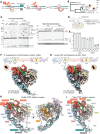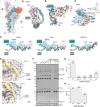Structures of vertebrate R2 retrotransposon complexes during target-primed reverse transcription and after second-strand nicking
- PMID: 40540573
- PMCID: PMC12180492
- DOI: 10.1126/sciadv.adu5533
Structures of vertebrate R2 retrotransposon complexes during target-primed reverse transcription and after second-strand nicking
Abstract
R2 retrotransposons are site-specific eukaryotic non-long terminal repeat retrotransposons that copy and paste into gene loci encoding ribosomal RNAs. Recently, we demonstrated that avian A-clade R2 proteins achieve efficient and precise insertion of transgenes into their native safe-harbor loci in human cells. The features of A-clade R2 proteins that support gene insertion are not well characterized. Here, we report high-resolution cryo-electron microscopy structures of two vertebrate A-clade R2 proteins at the initiation of target-primed reverse transcription and after cDNA synthesis and second-strand nicking. Using biochemical and cellular assays, we illuminate the basis for high selectivity of template use and unique roles for each of the three zinc-finger domains in nucleic acid recognition. Reverse transcriptase active site architecture is reinforced by an unanticipated insertion motif specific to vertebrate A-clade R2 proteins. Our work provides the first insights into A-clade R2 protein structure during gene insertion and may enable future improvement and adaptation of R2-based systems for precise transgene insertion.
Figures





Update of
-
Structures of vertebrate R2 retrotransposon complexes during target-primed reverse transcription and after second strand nicking.bioRxiv [Preprint]. 2024 Nov 20:2024.11.11.623112. doi: 10.1101/2024.11.11.623112. bioRxiv. 2024. Update in: Sci Adv. 2025 Jun 20;11(25):eadu5533. doi: 10.1126/sciadv.adu5533. PMID: 39605677 Free PMC article. Updated. Preprint.
Similar articles
-
Lineage-Specific Evolution, Structural Diversity, and Activity of R2 Retrotransposons in Animals.bioRxiv [Preprint]. 2025 May 9:2025.05.05.652312. doi: 10.1101/2025.05.05.652312. bioRxiv. 2025. PMID: 40654615 Free PMC article. Preprint.
-
Biology and utilization of R2 retrotransposons.RNA Biol. 2025 Dec;22(1):1-8. doi: 10.1080/15476286.2025.2521890. Epub 2025 Jun 25. RNA Biol. 2025. PMID: 40566873 Free PMC article. Review.
-
Structures of vertebrate R2 retrotransposon complexes during target-primed reverse transcription and after second strand nicking.bioRxiv [Preprint]. 2024 Nov 20:2024.11.11.623112. doi: 10.1101/2024.11.11.623112. bioRxiv. 2024. Update in: Sci Adv. 2025 Jun 20;11(25):eadu5533. doi: 10.1126/sciadv.adu5533. PMID: 39605677 Free PMC article. Updated. Preprint.
-
Reprogramming site-specific retrotransposon activity to new DNA sites.Nature. 2025 Jun;642(8069):1080-1089. doi: 10.1038/s41586-025-08877-4. Epub 2025 Apr 9. Nature. 2025. PMID: 40205048
-
Rapid, point-of-care antigen tests for diagnosis of SARS-CoV-2 infection.Cochrane Database Syst Rev. 2022 Jul 22;7(7):CD013705. doi: 10.1002/14651858.CD013705.pub3. Cochrane Database Syst Rev. 2022. PMID: 35866452 Free PMC article.
Cited by
-
Lineage-Specific Evolution, Structural Diversity, and Activity of R2 Retrotransposons in Animals.bioRxiv [Preprint]. 2025 May 9:2025.05.05.652312. doi: 10.1101/2025.05.05.652312. bioRxiv. 2025. PMID: 40654615 Free PMC article. Preprint.
-
Biology and utilization of R2 retrotransposons.RNA Biol. 2025 Dec;22(1):1-8. doi: 10.1080/15476286.2025.2521890. Epub 2025 Jun 25. RNA Biol. 2025. PMID: 40566873 Free PMC article. Review.
References
MeSH terms
Substances
Grants and funding
LinkOut - more resources
Full Text Sources

